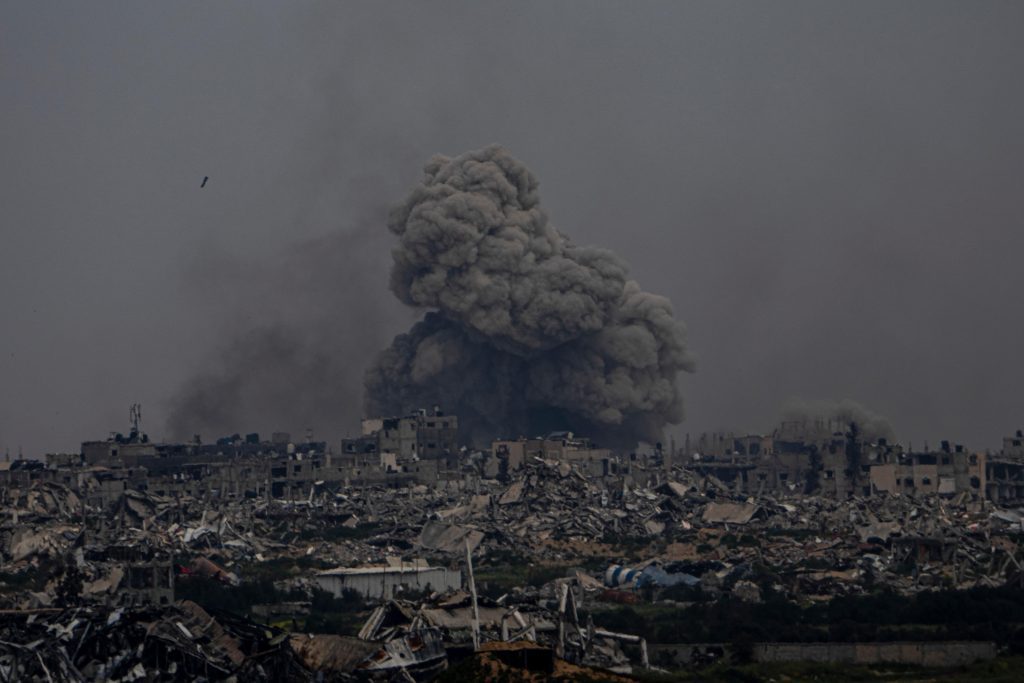By WAFAA SHURAFA, SAMY MAGDY and TIA GOLDENBERG (Associated Press)
In the Gaza Strip, the U.N. food agency announced that famine is very close in northern Gaza, where 70% of the remaining population is suffering from extreme hunger. This could push about half of Gaza’s total population to the brink of starvation if the war escalates further.
Israel is facing increasing pressure from its closest allies to make the entry of aid into Gaza easier and to open more land crossings. by air and The U.S. and other countries have been using sea deliveries in recent weeks, but aid groups say these are too slow and not large enough. Recently, the top diplomat of the European Union said that the upcoming famine is entirely man-made and that starvation is being used as a weapon of war.
Meanwhile, Israeli forces carried out another attack on the largest hospital in the Gaza Strip, stating that Hamas fighters had regrouped there and fired on them from inside the Shifa Hospital compound.
Clashes continued throughout the day in and around the hospital, where tens of thousands of people have been taking shelter, according to Palestinian officials. The army previously raided Shifa Hospital in November after claiming that Hamas had an extensive command center within and beneath the facility. The army found a tunnel leading to underground rooms and weapons, but critics accused the army of needlessly endangering the lives of civilians.
The army reported that 20 Hamas fighters were killed, as well as one of its own soldiers. It could not be confirmed if those killed were actually fighters. Among the killed was a senior commander in Gaza’s Hamas-led police forces, who Israel said was hiding in the hospital, but who Gaza officials said was coordinating the protection of aid convoys.
The army last raided Shifa Hospital in November after claiming that Hamas maintained an elaborate command center within and beneath the facility. The military revealed a tunnel leading to some underground rooms, as well as weapons it said were found inside the hospital. But the evidence fell short of the earlier claims, and critics accused the army of recklessly endangering the lives of civilians. RAFAH OFFENSIVE COULD PUSH HALF OF GAZA TO STARVATION The World Food Program released its latest findings on Monday, stating that virtually everyone in Gaza is struggling to get enough food, and about 677,000 people are experiencing the highest level of catastrophic hunger, with around 210,000 people in the north.
There are projections of an outright famine occurring in the north sometime between now and May. Famine would be declared when 20% of households have an extreme lack of food, 30% of children suffer from acute malnutrition, and at least two adults or four children per every 10,000 people die daily.
The report concluded that the first condition for famine has been met and it is highly likely that the second has as well. It is expected that the death rate will increase and reach famine levels soon.
It cautioned that if Israel expands its attack to
the densely populated southern city of Rafah
, as Prime Minister Benjamin Netanyahu has promised, the conflict could force over a million people — half of Gaza’s population — into severe hunger and potentially result in famine in the south.
“This is the largest number of people facing immediate famine in the world today, and it has only taken five months to happen,” said Matthew Hollingworth, the acting World Food Program country director for the Palestinian territories. “It’s still possible to change this situation but there must be a cease-fire and there must be significant amounts of food assistance to consistently arrive, and people need to have access to clean water and medical care,” he said.Jamie McGoldrick, the U.N. humanitarian coordinator for the Palestinian territories, urged for “all roads” to be opened for assistance, including into northern and central Gaza. The WFP report said aid from airdrops is “insignificant” compared to what is brought on trucks.
The first target of the invasion was Northern Gaza, including Gaza City, and
complete neighborhoods have been destroyed.
It is now the center of Gaza’s humanitarian disaster, with many residents resorting to eating animal feed.
At least 27 people, mostly children, , have died from malnutrition and dehydration in the north, according to the Health Ministry.Israeli authorities say they do not impose restrictions on the entry of aid and argue that U.N. bodies fail to distribute it promptly. Aid organizations claim that distribution is nearly impossible in much of Gaza due to hostilities, the challenge of coordinating with the military, and the breakdown of law and order. Alex de Waal, the executive director of the World Peace Foundation at Tufts University and an expert on global famines, stated that Israel has been given “plenty of warning” that if it continues to launch massive operations that destroy important infrastructure, displace large numbers of people, and impede aid operations, the consequences would be disastrous.“By refusing to change direction, it is responsible for these deaths,” he said.
EU foreign policy chief Josep Borrell stated that it was up to Israel to facilitate more aid.
“Israel has to do it. It is not a matter of logistics. It is not because the United Nations has not provided enough support,” he said. “Trucks are halted. People are dying, while the land crossings are artificially closed.”
‘WE’RE TRAPPED INSIDE’
The attack on Shifa Hospital began before dawn, when Israeli forces supported by tanks and artillery surrounded the complex and troops entered several buildings.
“We’re trapped inside,” said Abdel-Hady Sayed, who has been seeking shelter in the facility for months. “They shoot at anything moving.” In the evening, he mentioned that tanks were still in the hospital yard and he could see three bodies outside the gates. “We can’t retrieve the dead,” he said.
The Health Ministry of Gaza reported that around 30,000 people are taking shelter at the hospital, including patients, medical staff, and individuals who have fled their homes for safety. The war has displaced about 80% of Gaza’s population.
Rear Adm. Daniel Hagari, the chief Israeli military spokesperson, claimed that senior Hamas fighters had regrouped in the hospital and were directing attacks from within.
Faiq Mabhouh, a high-ranking officer in Gaza's police force, was among those killed in the attack. The Israeli military claimed he was armed and hiding in Shifa, and found weapons in a nearby room.
The Gaza government stated that Mabhouh oversaw aid distribution in the north and coordinated between aid groups and local tribes. Aid organizations believe Israeli strikes on police have contributed to the breakdown of public order, leading to desperate Palestinians overwhelming aid trucks.
Hagari stated that the patients and medical staff had the option to stay in the medical complex, and there was a safe way out for civilians who wished to leave.
Israel accuses Hamas of using hospitals and other civilian facilities to protect its fighters, and the Israeli military has conducted multiple raids on hospitals since the start of the war.
The Gaza Health Ministry reported Monday that at least 31,726 Palestinians have been killed in Israel’s offensive.
doesn’t differentiate
between civilians and combatants in its count, but says
women and children make up two-thirds of the dead. Palestinian terrorists killed some 1,200 people in Hamas’ Oct. 7 attack into southern Israel that triggered the war, and took another 250 people hostage. Hamas is still believed to be holding about 100 captives, as well as the remains of 30 others, after most of the rest were freed during a cease-fire last year.
Magdy reported from Cairo and Goldenberg from Tel Aviv, Israel. Associated Press writer Lorne Cook in Brussels contributed. Find more of AP’s coverage at https://apnews.com/hub/israel-hamas-war
The U.N. food agency warns that “famine is imminent” in northern Gaza, where 70% of the remaining population is facing catastrophic hunger.
Find more of AP’s coverage at https://apnews.com/hub/israel-hamas-war









